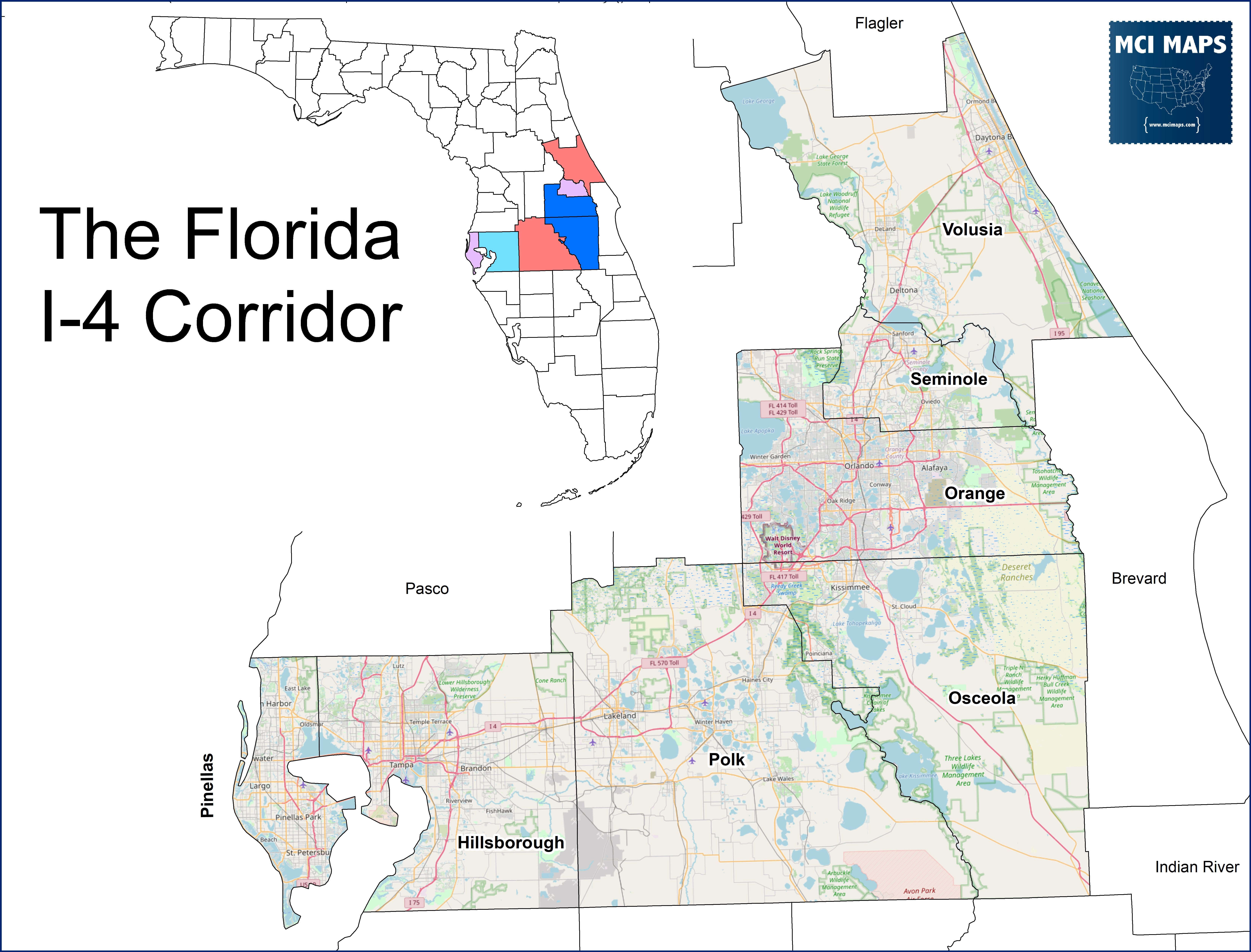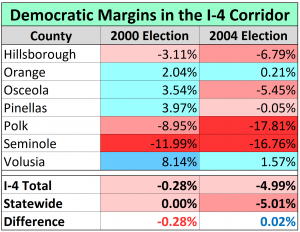A staple of Florida election coverage for much of the 21st century has been the “I-4 Corridor.” With every election comes discussion about the different regions of the state – and the I-4 Corridor has long been discussed as a pivotal region.
So for my non-Floridian readers, what is the I-4 corridor? The region is largely defined as the seven counties that stretch from Pinellas to Volusia – linked by the I-4 Highway (which connects I-75 in the West and I-95 in the east) and other assorted highways.
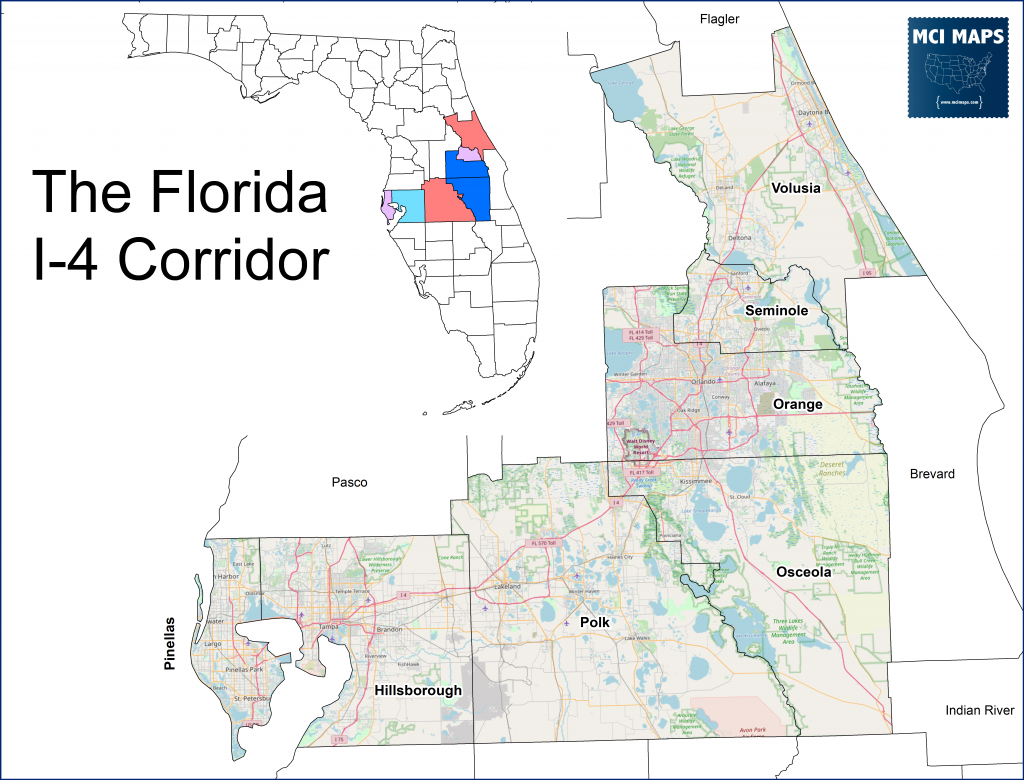
These counties all hold huge numbers of voters. Osceola is the least populated but still has 280,000 people.. Pinellas, Orange, and Hillsborough all have around 1 million or more people. A brief breakdown of these counties in order from West to East
- Pinellas – a working-class county that has long been a swing region in the area. Originally the place of birth of the modern FL GOP several decades earlier. The county includes the more-liberal St Petersburg region and its African-American voting block; as well as mid-county working class voters. It has just under 1 million people in it.
- Hillsborough – A large county that includes the City of Tampa and its metro zone’s sprawling urban and suburban communities. This area is a mixture of urban and suburban, with a still notable rural region in its east area. The district has a growing Hispanic population, especially concentrated in its western communities of Citrus Park, Northdale, and Carrollwood. It has an estimated population of 1.4 million people.
- Polk – A more rural county, with key population blocks in cities like Lakeland and Winter Haven. The area has seen population growth across towns by the I-4 highway – though many regions of the county are still more rural. Polk is the largest county by area in Florida. An estimated 700,000 people live there.
- Osceola – A vast majority of the county’s population is clustered in its northwest, with much of the southern end and west area of the country being rural and ranches. The two main cities are Kissimmee and St Cloud. The county has seen massive Hispanic population growth – with a growing Puerto Rican population. A plurality of voters in the county are now Hispanic. It is the lowest populated county due to most folks being in the northwest edge, sitting at just under 300,000 people.
- Orange – An ever dense and diverse Orange County is home to Orlando, the Disney Parks, and many communities and towns. The county has added 500,000 voters since 2000; sitting at an estimated 1.4 million people. Like Osceola, the county has seen major growth in Hispanic population. The county has everything; a dense urban core, suburbs, and rural communities on its eastern and northwestern borders.
- Seminole – Originally viewed as a sleepy suburb of Orange County, this area has seen major growth as well. The county is a mixture of 7 different cities. Like Orange, it has seen growing diversity in its voter makeup – with its Hispanic voter registration nearly doubling from 8% to 15% since 2006. Just over 400,000 people currently reside there.
- Volusia – A working-class county on the east coast of Florida. Volusia is home to Daytona Beach (of Spring Break legend) and holds a large mix of coastal and inland communities. The county has also seen an increase in retiree communities in recent years. Right around 500,000 live there.
Population density in the corridor is strongest in the cities and along the highways and major roads. Much of its southeast is rural.
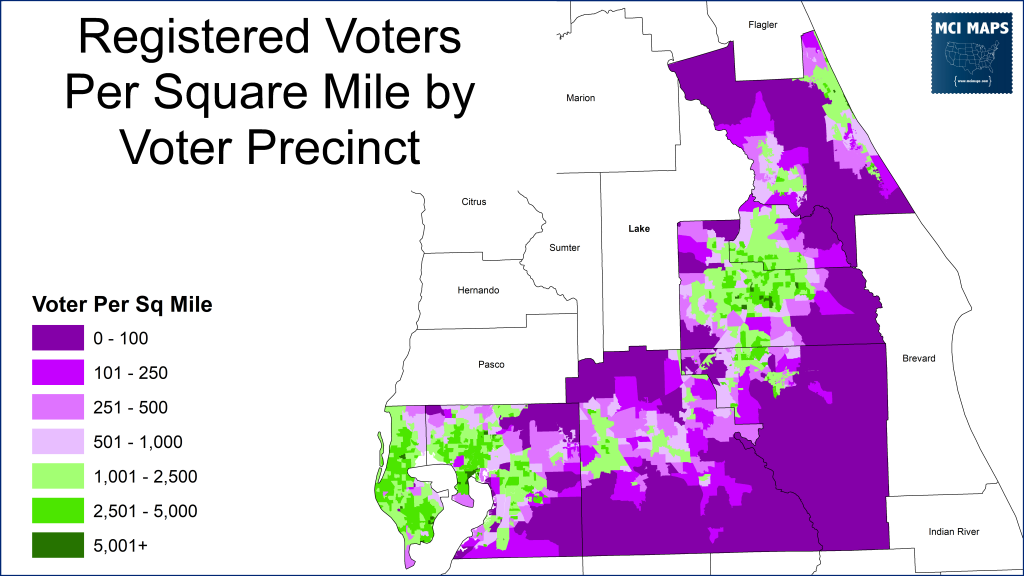
Lets now look at the corridor in Presidential elections.
The 2000 and 2004 Elections
The I-4 corridor became a major political talking point in the early 2000s when the region appeared to perfectly mimic statewide results. The region’s mix of suburbs, urban cores, and rural voters make it a microcosm of the state. In addition, the area around the I-4 roadway was seeing growth that matched the state. In both the 2000 and 2004 Presidential elections, the I-4 corridor was within less than 0.5% of the statewide result.
The corridor counties were notably not in lock-step with each-other, but in 2000 the biggest gap was a 20 point margin (between the 12% GOP win in Seminole and 8% Democratic win in Volusia). In 2004, that gap roughly stayed the same as all counties moved to the right – reflecting Bush’s 5 point win.
However, the lock-step with the statewide numbers would quickly come to an end. Demographic shifts were taking place in the I-4 that were outpacing the rests of the state. Notably Hispanic populations were rising. Bush had managed a decent Hispanic showing in 2004, but this would shift in 2008 and beyond.
Changing Demographics
Hispanic populations around Orlando and Tampa had been the norm for some time in the area. The Orlando region especially became a major destination for the Puerto Rican population before the 2000s, and between 1990 and 2000 the Orlando market had the largest % increase (142%) of Puerto Ricans in any state. Puerto Ricans grew to see Florida has a better destination than New York City thanks to better employment opportunities, lower housing costs, and a climate more similar to the island. The growth of the community became an incentive for islanders looking to come stateside also considering the Orlando region as a destination. All this has led to a continued growth of the Puerto Rican, and overall Hispanic, community in the Orlando market.
Florida began tracking the Hispanic share of voter registration in 2006, and the figures show a continued growth in Hispanic share of the voting pool from 2006 to 2020. The hispanic share of voters has nearly doubled, well beyond the modest gains of the African-American, Asian, Native, and mixed-race populations.
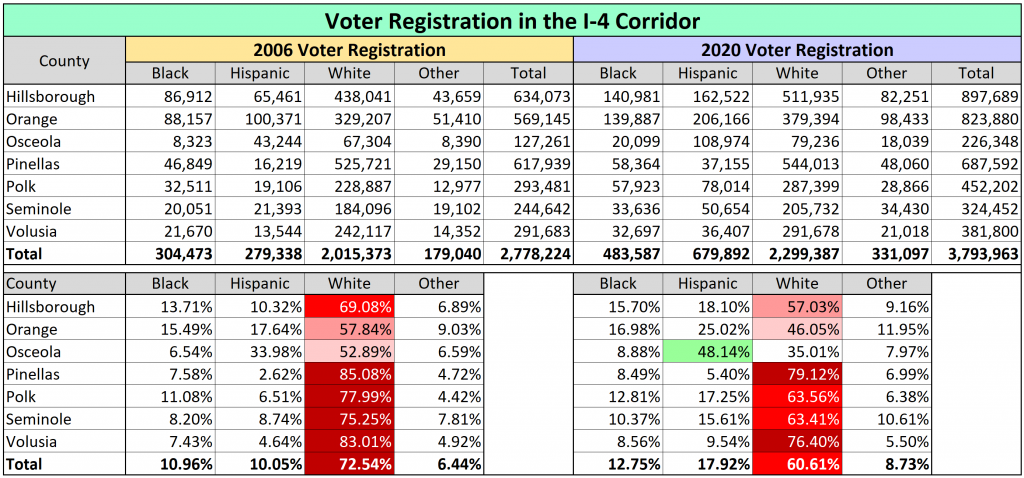
The non-white rise in registration has made both Orlando and Orange county majority-minority counties, with Hillsborough not far behind.
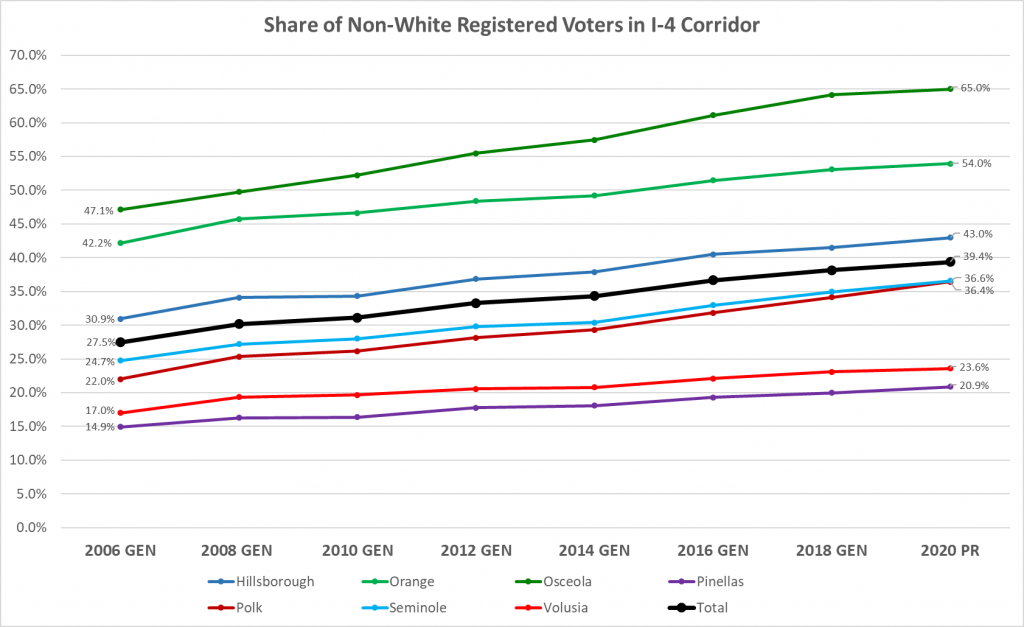
Every county is seeing growth, but Volusia and Pinellas still by far remain the most white – well below the region’s average.
Here map below shows voter registration by race.
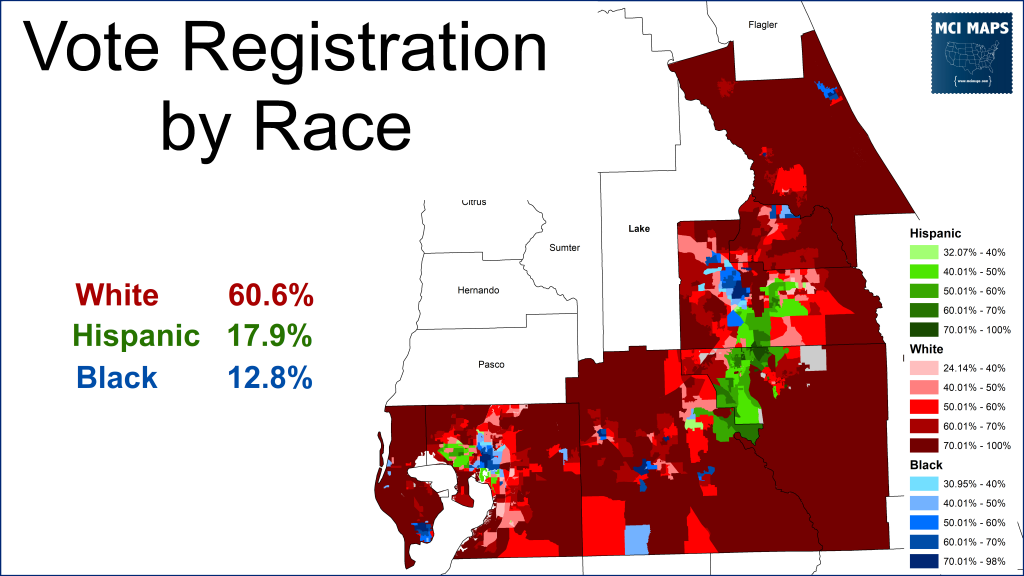
As the map shows, many areas of the county are overwhelmingly white – with pockets of African-American and Hispanic voters in the cities. The Hispanic population has its own mini-corridor stretching from central Orlando and down into Polk. The Hispanic community of Hillsborough also stands out.
Movement to the Left
By 2008, the non-white population of the corridor had grown larger than ever and the Barack Obama’s organization machine – which not only registered tens of thousands of people across the state – but turned them out – caused a major political shift in the I-4 corridor. While Obama would go on to win the state by 3%, he won the I-4 by nearly 8 points.
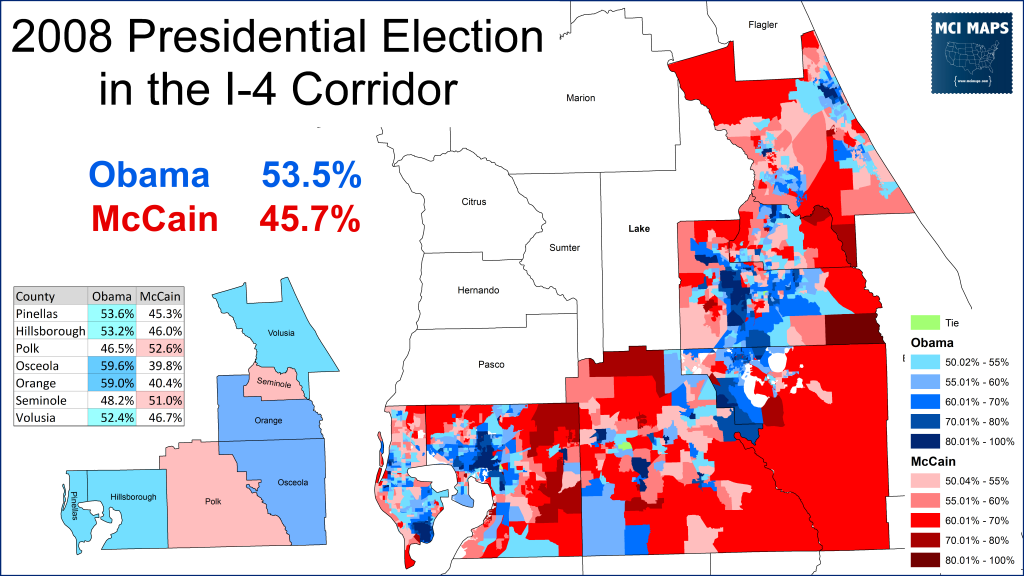
Obama’s dominant performance with Hispanic voters, as well as their growing share of the vote, resulted in record democratic performances in the Orlando and Osceola region. Every county swung left. However, the gap between the counties actually grew. The 20% DEM margin in Osceola and 6% GOP margin in Polk led to a 26 point gap.
When the 2012 Presidential election came along, Obama secured a narrow 1% win statewide, but he maintained a 6% margin in the I-4. The gap between the state and I-4 narrowly grew as a result. The Obama campaign’s strategy against Romney had always been to maximize turnout with young and non-white voters, and in a region with a growing non-white population, the success of this plan bore fruit.
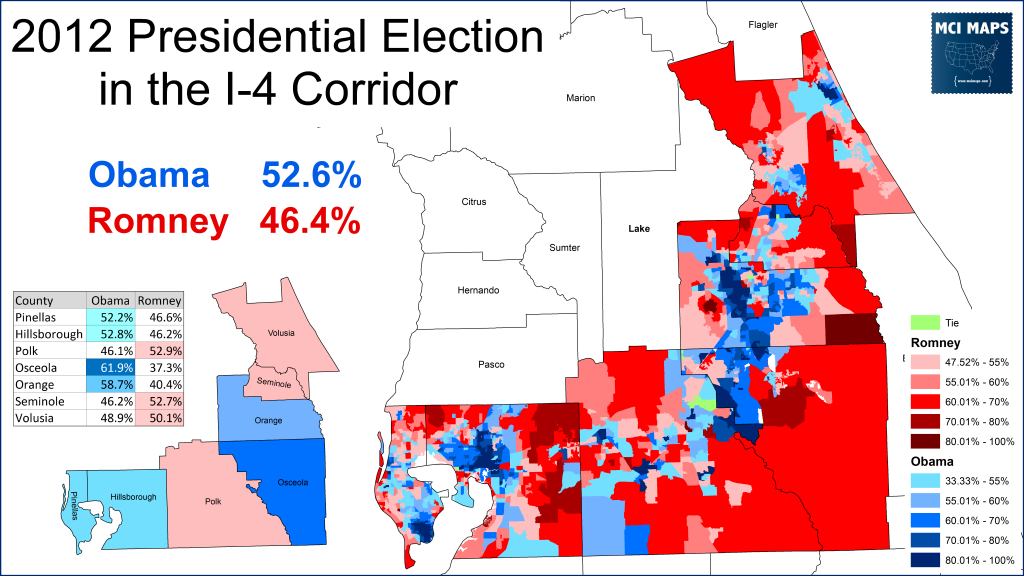
Obama lost some ground with white voters; resulting in a smaller margin in Pinellas, the loss of Volusia, and a move to the right in Polk and Seminole. Obama managed to keep the margin almost the same in Hillsborough and Orange, where some white losses were balanced by non-white growth, and increase the Osceola margin by several points. The gap between the counties grew wide, as Polk’s 7% GOP edge vs Osceola’s 24% DEM edge meant a 31 point gap!
Then came 2016, which saw several notable demographic shifts. Hillary Clinton lost Florida to Donald Trump by a 1.2% margin. However, she held the I-4 by 5%. This meant a 6 point difference – the highest yet in a Presidential race.
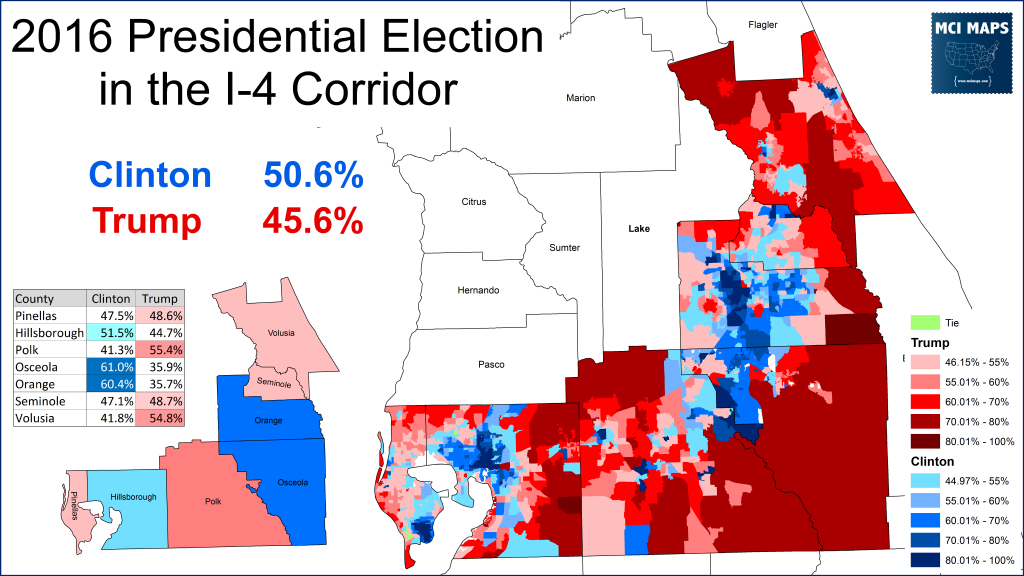
Clinton saw rightward shifts in Volusia, Pinellas, and Polk as white working class voters rebelled against the Democrats. However, suburban shifts to Clinton and away from Trump allowed Clinton to hold the same margin in Hillsborough. Those suburban shifts and an increase in Hispanic support saw Clinton to improve over Obama in Seminole, Osceola, and Orange. Clinton’s 25% margin in Osceola balanced against Trump’s 14% win in Polk led to a gap of 39 points; double the gap between counties in 2000 and 2004!
A precinct-level shift between 2012 and 2016 can be seen below. It reveals how the trendlines changed depending on the community and demographic.
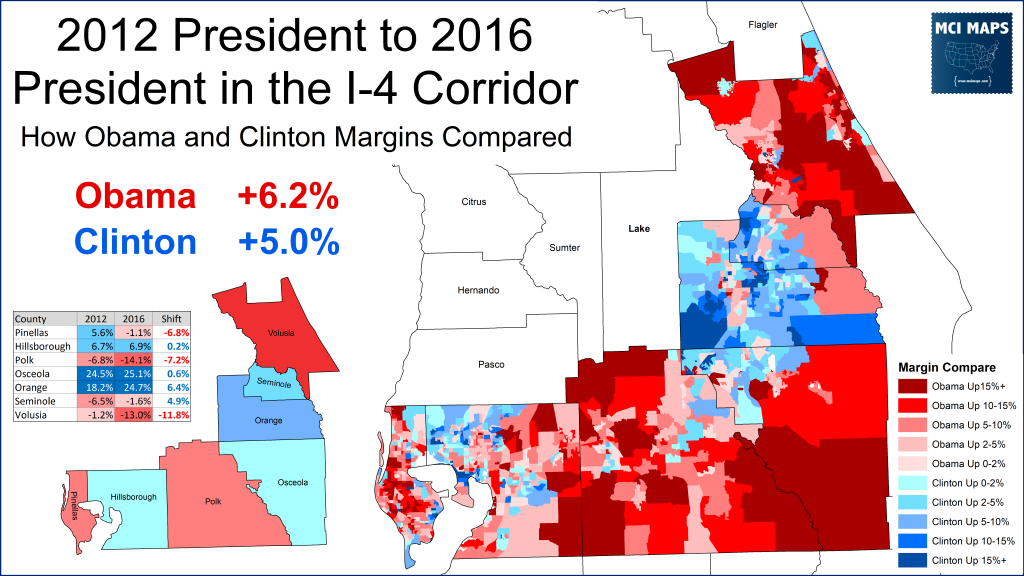
Clinton lost big in white, working class areas – and even modestly in African-American areas (thanks to weaker turnout and Obama’s record levels there). Clinton made big gains, however, in suburbs and Hispanic areas.
These graphs show how the I-4’s counties moved away from each-other. Namely the rise of Orlando and Osceola as locked-in democratic voting pools and a shift to the right in Polk and Volusia. Seminole and Pinellas are now the perfect swing counties – each for their unique demographic reasons.
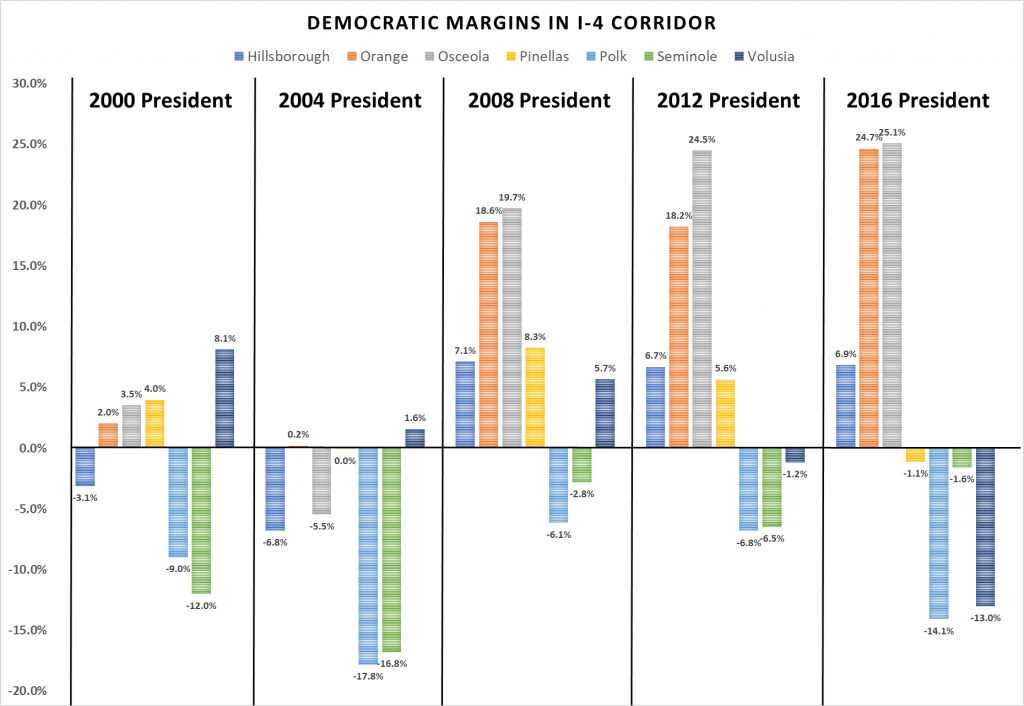
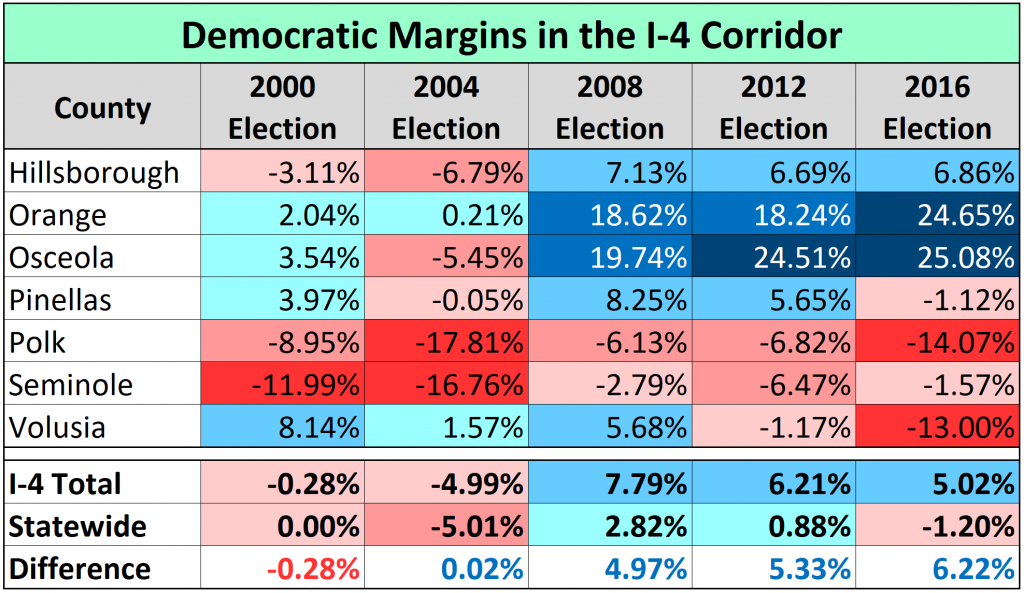
While the region’s counties were not perfectly in-sync with each-other in the early 2000s, they were much closer in politics. However, the shifting political allegiances or different groups and growth around Orlando have left a wide gap in these counties. This has also put the region decidedly to the left of the state. No longer is it the case that someone must win the I-4 to win Florida. For Democrats, they must win it by a decent margin. Meanwhile, a Republican taking the I-4 likely means an sizeable statewide win.
Warning for Democrats in 2018
Heading into 2020, each side knows what its target demographics are in the I-4. The 2018 Gubernatorial election in the I-4 should demonstrate, however, how voters in these different demographic groups can move. For example, here is Gillum vs DeSantis in the I-4.
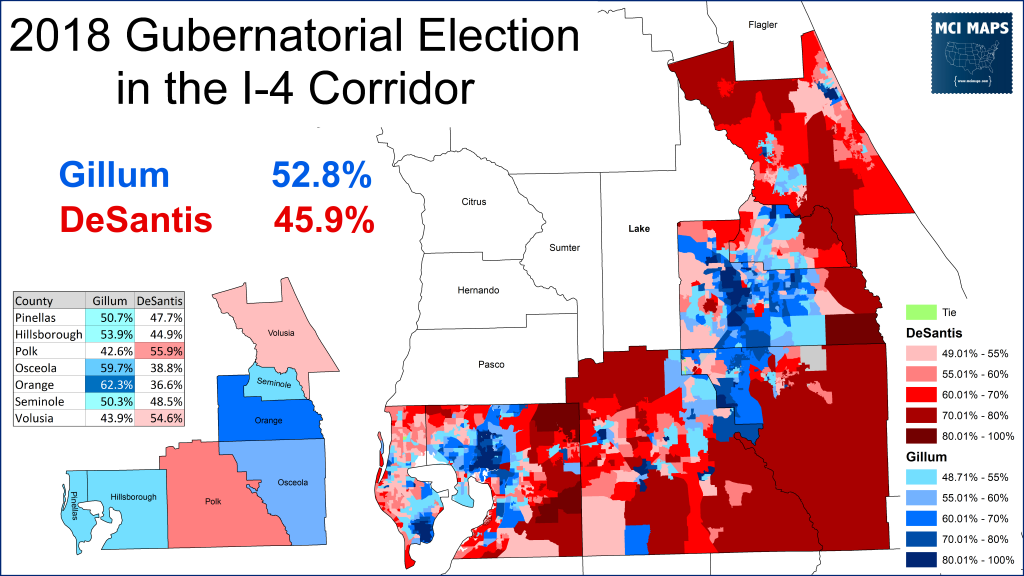
Gillum secured a solid 6.9% win in the region, but narrowly lost the state. This 7% gap is a new record for the corridor in a major race. But the reason Gillum lost can be seen both inside and outside the corridor.
Lets look at the swing map between 2016 and 2018. Gillum actually gained over Clinton across 6 of the 7 counties. He made modest improvements with white working class voters and African-American turnout was good. Of curse, the Volusia margin and other WWC margins were still well below Obama 2008 or 2012 numbers. The big problem for Gillum, though, was Hispanic voters. The campaign under-performed in Hispanic voters as the GOP, especially Rick Scott, worked in 2018 to win some Puerto Ricans over. In the end, Gillum still won this demographic handily, but he did lose ground compared to Clinton’s record margins.
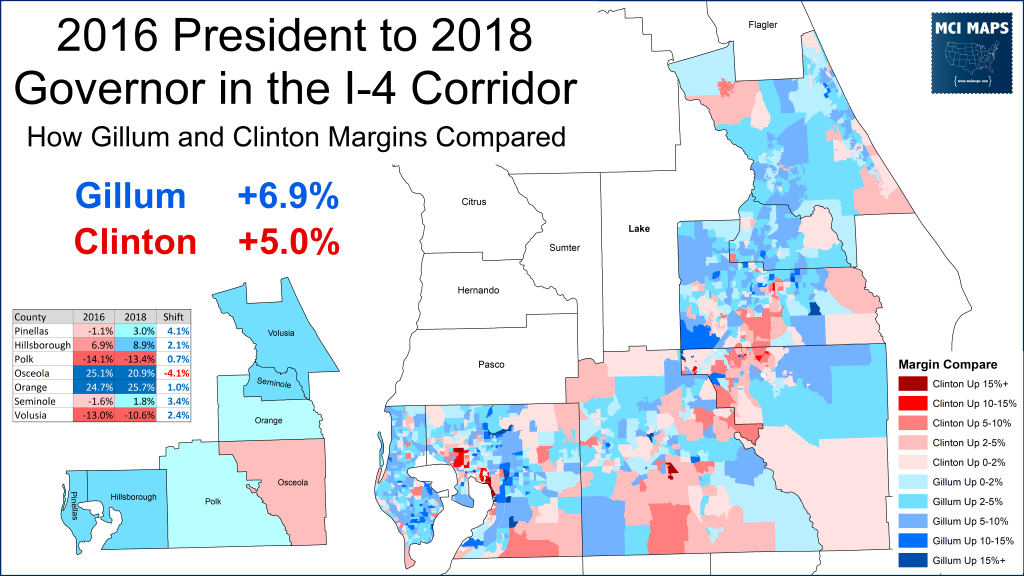
This shift with Hispanics can be seen clearer when breaking results down by state house seat. District 48, 49, 42, and 62 all have sizable Hispanic populations.
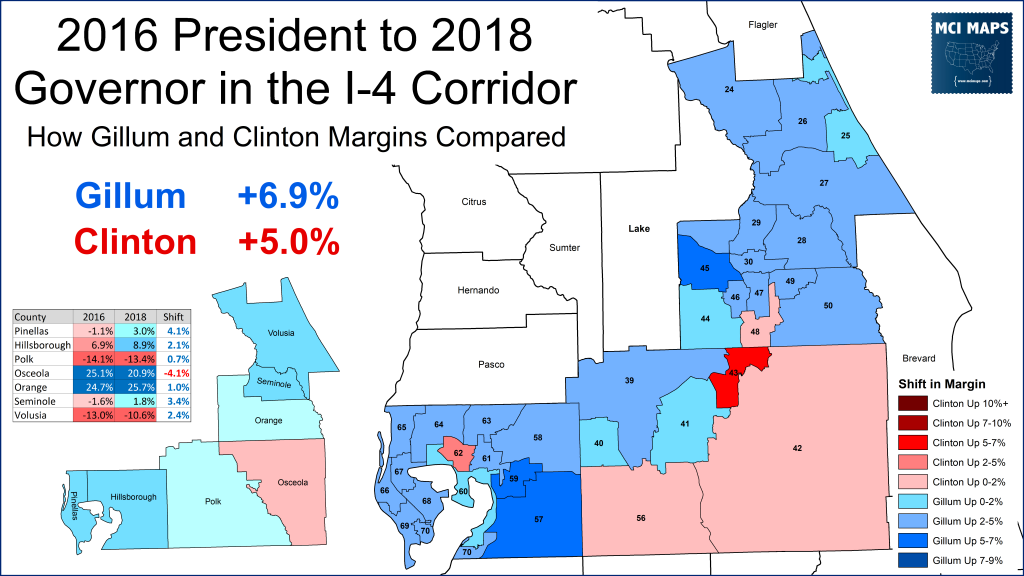
I wrote more in depth about the Hispanic issue for Democrats in 2018 when I covered the right-ward shift in Miami-Dade. Some of these drops were weaker turnout among dem-friendly Hispanics compared to GOP-leaning Cubans, but they also reflect gains the GOP made with these voters over pocketbook issues. Hispanics are important constituency this election as both campaigns focus on the community. For the GOP, they don’t need to win the Hispanic vote, they just need to narrow the margin. Democrats, meanwhile, see Biden as someone who can improve with white voters in the Volusia and Pinellas region.
Local Realignment
The shifts we have seen at the federal and state level have also appeared further down-ballot. As the Orlando and Tampa regions became bluer, their local governments slowly followed. In 2012, most counties still saw GOP control of their county commissioners. Only Volusia, which had narrowly backed Romney, was in Democratic hands. Over the next several cycles, the situation would slowly involve
- In 2014, Pinellas Democrats would gain the last at-large seat, giving them a 4-3 control by holding all 3 at-large seats and 1 single-member seat. Osceola Democrats would also flip both GOP-controlled county seats up that year – both Democratic-leaning federally and located in the west end of the county. Republicans, meanwhile, would flip a commission seat in Volusia and take control of the commission.
- In 2016, Democrats make a gain in the officially non-partisan Orange Commission. Despite Trump taking Pinellas, Democrats held the at-large seats in the county by close margins. Democrats lost big in Volusia as Trump dominated the county.
- In 2018, Democrats came back big in Orange and Hillsborough. They swept two at-large races in Hillsborough and won control of the board. In Orange, Democrats won the county-wide mayoral election and two additional single-member districts.
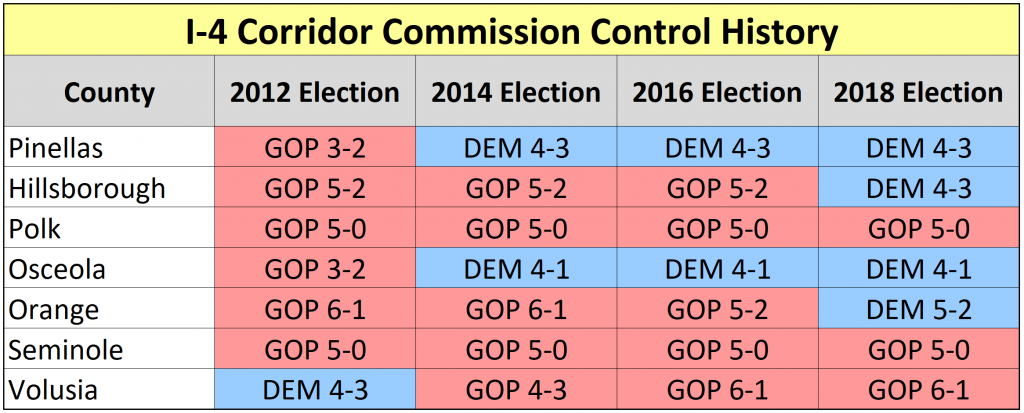
The local results have come much more in line with the partisan lean of the counties. Seminole is by far the biggest outlier at 5-0 GOP despite Democrats making gains there. However, the Democratic evolution at the local level is underway. 2020 is seeing an unprecedented number of local democratic candidates for offices that were often GOP-only affairs a few years ago. Seminole’s move to a swing county has also led to Democrats targeting state legislative seats in the area as well – with State Senate District 9 being a top Democratic pickup target this year.
The shift in vote-rich Orlando is especially notable because the commission is officially non-partisan. However, the Democrats have successfully pushed to make these races more political and focused on policy issues. Democrats already picked up another seat in August of this year. When the new commission meets in 2021, they will control all but 1 seat.
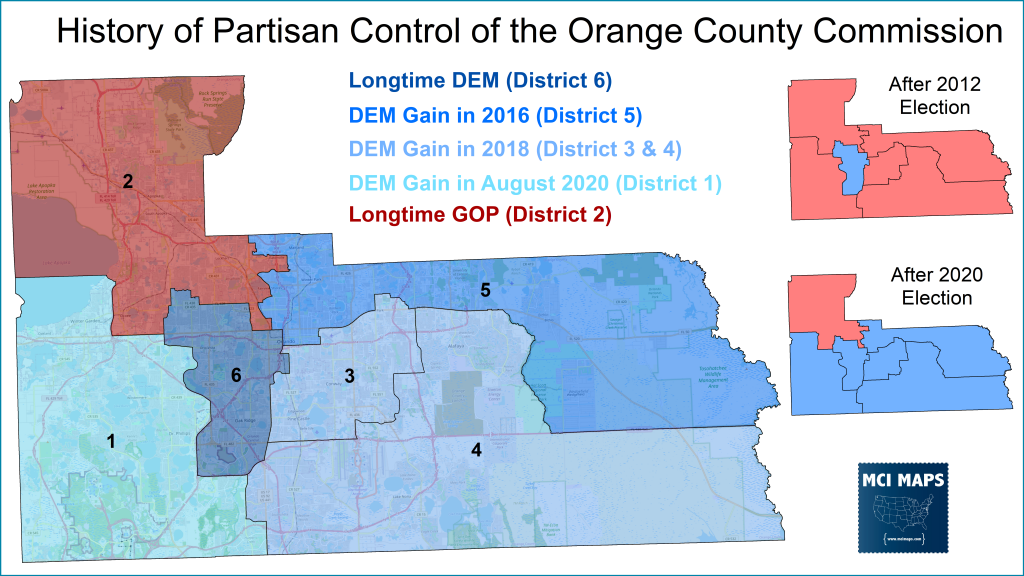
The down-ballot shifts in each county are a strong indicator that these trends will be the norm for several cycles to come.
Conclusion
The I-4 Corridor has been part of Florida political legend for 20 years. Its growth and diversification is still a microcosm for the state as a whole. However, thanks to smaller pockets of GOP votes (like midwestern retirees and rural communities), the region has moved notably to the left of the state as a whole. The I-4’s counties have also moved further away from each-other thanks to specific demographic shifts. In those respects, the corridor continues to represent Florida – which continues to see its counties break off into dark red or dark blue pockets.

